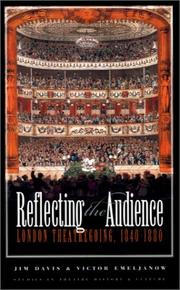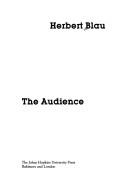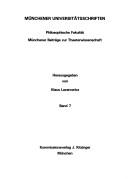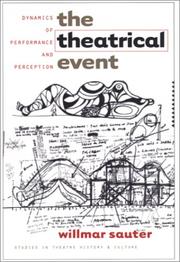| Listing 1 - 10 of 62 | << page >> |
Sort by
|

ISBN: 1587294028 9781587294020 9780877457817 0877457816 Year: 2001 Publisher: Iowa City University of Iowa Press
Abstract | Keywords | Export | Availability | Bookmark
 Loading...
Loading...Choose an application
- Reference Manager
- EndNote
- RefWorks (Direct export to RefWorks)
This innovative work begins to fill a large gap in theatre studies: the lack of any comprehensive study of nineteenth-century British theatre audiences. In an attempt to bring some order to the enormous amount of available primary material, Jim Davis and Victor Emeljanow focus on London from 1840, immediately prior to the deregulation of that city's theatres, to 1880, when the Metropolitan Board of Works assumed responsibility for their licensing. In a further attempt to manage their material, they concentrate chapter by chapter on seven representative theatres from four areas:
Theater audiences --- Theater --- Audiences, Theater --- Theatergoers --- Performing arts --- Theater attendance --- History --- Audiences
Book
ISBN: 0817386327 9780817386320 0817370072 9780817370077 9780817370077 9780817386320 Year: 2012 Publisher: Tuscaloosa : University of Alabama Press,
Abstract | Keywords | Export | Availability | Bookmark
 Loading...
Loading...Choose an application
- Reference Manager
- EndNote
- RefWorks (Direct export to RefWorks)
The audience is an integral part of performance and is in fact what separates a rehearsal from a performance. The relationship, however, between performers and the audience has evolved over time, which is one of the subjects addressed, along with the changing disposition of the audience itself and a number of other topics, in Gods and Groundlings, volume 20 of the annual journal Theatre Symposium. The essays in this volume discuss spectatorship in historical context, the role of the audience in the digital age, the early modern English transvestite theatre, Annie Oakley
Theater audiences. --- Theater --- Audiences, Theater --- Theatergoers --- Performing arts --- Theater attendance --- History. --- Audiences
Book
ISBN: 9781107338791 9781107043602 9781107417632 1107417635 1107338794 1107043603 1107425697 1139893653 1107423384 1107420253 1107421608 1107418933 1306072158 1108458076 9781107425699 9781139893657 9781107423381 9781107420250 9781107421608 9781107418936 Year: 2013 Publisher: Cambridge Cambridge university press
Abstract | Keywords | Export | Availability | Bookmark
 Loading...
Loading...Choose an application
- Reference Manager
- EndNote
- RefWorks (Direct export to RefWorks)
By 1800 London had as many theatre seats for sale as the city's population. This was the start of the capital's rise as a centre for performing arts. Bringing to life a period of extraordinary theatrical vitality, David Worrall re-examines the beginnings of celebrity culture amidst a monopolistic commercial theatrical marketplace. The book presents an innovative transposition of social assemblage theory into performance history. It argues that the cultural meaning of drama changes with every change in the performance location. This theoretical model is applied to a wide range of archival materials including censor's manuscripts, theatre ledger books, performance schedules, unfamiliar play texts and rare printed sources. By examining prompters' records, box office receipts and benefit night takings, the study questions the status of David Garrick, Sarah Siddons and Edmund Kean, and recovers the neglected actress, Elizabeth Younge, and her importance to Edmund Burke.
Theater audiences --- Theater --- Audiences, Theater --- Theatergoers --- Performing arts --- Theater attendance --- History --- Audiences
Book
ISBN: 1282413171 9786612413179 144381461X 9781443814614 Year: 2005 Publisher: Newcastle upon Tyne Cambridge Scholars Publishing
Abstract | Keywords | Export | Availability | Bookmark
 Loading...
Loading...Choose an application
- Reference Manager
- EndNote
- RefWorks (Direct export to RefWorks)
Twenty major German cities have a total of twenty-four theatres specializing, at a high level of sophistication, in presenting light comedy. They have their own typical ambience, principles of artistic management and casting. There are playwrights, actors, directors and designers who work almost exclusively in the genre, called boulevard comedy, developing highly specialised approaches to their work. In almost all cases, the predominantly privately run boulevard comedy theatres in Germany hav...
Theater --- Theaters --- Theater audiences --- German drama (Comedy) --- Audiences, Theater --- Theatergoers --- Performing arts --- Theater attendance --- History and criticism. --- Audiences
Book
ISBN: 3701305943 9783701305940 Year: 1979 Publisher: Salzburg Müller
Abstract | Keywords | Export | Availability | Bookmark
 Loading...
Loading...Choose an application
- Reference Manager
- EndNote
- RefWorks (Direct export to RefWorks)
Theatrical science --- Antiquity --- Theater audiences --- -Theater audiences --- -Theater --- -Dramatics --- Histrionics --- Professional theater --- Stage --- Theatre --- Performing arts --- Acting --- Actors --- Audiences, Theater --- Theater --- Theatergoers --- Theater attendance --- History --- -Audiences --- Audiences --- -History
Book
ISBN: 3700101066 Year: 1975 Publisher: Wien Österreichische Akademie der Wissenschaften
Abstract | Keywords | Export | Availability | Bookmark
 Loading...
Loading...Choose an application
- Reference Manager
- EndNote
- RefWorks (Direct export to RefWorks)
History of civilization --- Theatrical science --- Theater audiences --- -Audiences, Theater --- Theater --- Theatergoers --- Performing arts --- Theater attendance --- Caricatures and cartoons --- Audiences --- Caricatures and cartoons. --- -Caricatures and cartoons --- Audiences, Theater

ISBN: 0801838444 0801838452 Year: 1990 Publisher: Baltimore Johns Hopkins university press
Abstract | Keywords | Export | Availability | Bookmark
 Loading...
Loading...Choose an application
- Reference Manager
- EndNote
- RefWorks (Direct export to RefWorks)
Theatrical science --- Theater audiences --- Théâtre --- Publics --- 82-2 --- Audiences, Theater --- Theater --- Theatergoers --- Performing arts --- Theater attendance --- Toneel. Drama --- Audiences --- 82-2 Toneel. Drama --- Théâtre
Book
ISBN: 9789004329768 9789004329751 9004329765 9004329757 Year: 2017 Publisher: Leiden; Boston Brill
Abstract | Keywords | Export | Availability | Bookmark
 Loading...
Loading...Choose an application
- Reference Manager
- EndNote
- RefWorks (Direct export to RefWorks)
In Dramatic Experience: The Poetics of Drama and the Early Modern Public Sphere(s) Katja Gvozdeva, Tatiana Korneeva, and Kirill Ospovat (editions.) focus on a fundamental question that transcends the disciplinary boundaries of theatre studies: how and to what extent did the convergence of dramatic theory, theatrical practice, and various modes of audience experience — among both theatregoers and readers of drama — contribute, during the sixteenth to eighteenth centuries, to the emergence of symbolic, social, and cultural space(s) we call ‘public sphere(s)’? Developing a post-Habermasian understanding of the public sphere, the articles in this collection demonstrate that related, if diverging, conceptions of the ‘public’ existed in a variety of forms, locations, and cultures across early modern Europe — and in Asia.
Theatrical science --- drama [literature] --- anno 1500-1799 --- Theater. --- Theater audiences. --- Audiences, Theater --- Theater --- Theatergoers --- Performing arts --- Theater attendance --- Dramatics --- Histrionics --- Professional theater --- Stage --- Theatre --- Acting --- Actors --- Audiences

ISBN: 3920645286 Year: 1980 Publisher: München Kitzinger
Abstract | Keywords | Export | Availability | Bookmark
 Loading...
Loading...Choose an application
- Reference Manager
- EndNote
- RefWorks (Direct export to RefWorks)
Theater audiences --- 792.01 --- 792.01 Theater: theorie; esthetica --- Theater: theorie; esthetica --- Audiences, Theater --- Theater --- Theatergoers --- Performing arts --- Theater attendance --- Measurement --- Audiences --- Theatrical science

ISBN: 1587293404 9781587293405 9780877457312 087745731X Year: 2000 Publisher: Iowa City University of Iowa Press
Abstract | Keywords | Export | Availability | Bookmark
 Loading...
Loading...Choose an application
- Reference Manager
- EndNote
- RefWorks (Direct export to RefWorks)
The Theatrical Event discusses the objectives of theatre studies by focusing on the communicative encounter between performer and spectator-the theatrical event. A theatrical event includes the presentation of a performance and the attention of an audience; in this sense, every performance-on stage or in the street, historical or contemporary-that is watched by an audience is a theatrical event. The concept underlines the "eventness" of all encounters between performers and spectators.In the first part of the book, Willmar Sauter presents various models
Theater --- European drama --- Theater audiences --- Audiences, Theater --- Theatergoers --- Performing arts --- Theater attendance --- Dramatics --- Histrionics --- Professional theater --- Stage --- Theatre --- Acting --- Actors --- History --- Political aspects --- History and criticism. --- Audiences
| Listing 1 - 10 of 62 | << page >> |
Sort by
|

 Search
Search Feedback
Feedback About UniCat
About UniCat  Help
Help News
News